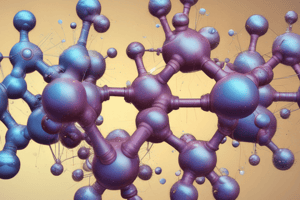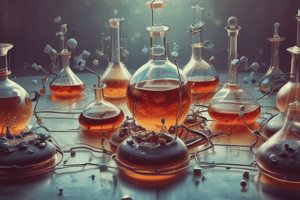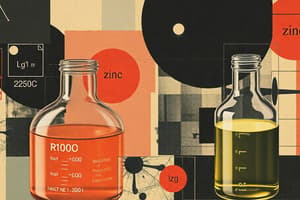Podcast
Questions and Answers
When a metal reacts with an acid, it forms a salt and ______ gas.
When a metal reacts with an acid, it forms a salt and ______ gas.
hydrogen
The reaction between sodium hydroxide and zinc produces sodium ______ and hydrogen gas.
The reaction between sodium hydroxide and zinc produces sodium ______ and hydrogen gas.
zincate
Not all metals are able to react with sodium ______ to produce hydrogen gas.
Not all metals are able to react with sodium ______ to produce hydrogen gas.
hydroxide
Sodium carbonate has the chemical formula ______.
Sodium carbonate has the chemical formula ______.
Signup and view all the answers
Sodium hydrogencarbonate has the chemical formula ______.
Sodium hydrogencarbonate has the chemical formula ______.
Signup and view all the answers
When sodium carbonate reacts with dilute hydrochloric acid, a ______ is produced.
When sodium carbonate reacts with dilute hydrochloric acid, a ______ is produced.
Signup and view all the answers
The gas produced from the reaction of carbonates with acids is passed through ______ water to test for its presence.
The gas produced from the reaction of carbonates with acids is passed through ______ water to test for its presence.
Signup and view all the answers
Lime water is also known as calcium ______ solution.
Lime water is also known as calcium ______ solution.
Signup and view all the answers
When metal reacts with acid it produces salt and ______ gas.
When metal reacts with acid it produces salt and ______ gas.
Signup and view all the answers
The reaction of sodium hydroxide with zinc produces hydrogen and sodium ______.
The reaction of sodium hydroxide with zinc produces hydrogen and sodium ______.
Signup and view all the answers
When a metal reacts with an acid, it displaces ______ atoms from the acid as hydrogen gas.
When a metal reacts with an acid, it displaces ______ atoms from the acid as hydrogen gas.
Signup and view all the answers
The general equation for the reaction of a metal with an acid can be summarized as Acid + Metal → Salt + ______ gas.
The general equation for the reaction of a metal with an acid can be summarized as Acid + Metal → Salt + ______ gas.
Signup and view all the answers
When granulated zinc metal reacts with sodium hydroxide, ______ gas is formed.
When granulated zinc metal reacts with sodium hydroxide, ______ gas is formed.
Signup and view all the answers
The reaction between sodium hydroxide and zinc metal produces sodium zincate and ______.
The reaction between sodium hydroxide and zinc metal produces sodium zincate and ______.
Signup and view all the answers
The chemical formula for sodium zincate, which is produced when zinc reacts with sodium hydroxide, is ______.
The chemical formula for sodium zincate, which is produced when zinc reacts with sodium hydroxide, is ______.
Signup and view all the answers
Sodium hydrogencarbonate is also commonly known as baking soda, and its chemical formula is ______.
Sodium hydrogencarbonate is also commonly known as baking soda, and its chemical formula is ______.
Signup and view all the answers
When sodium carbonate or sodium hydrogencarbonate reacts with dilute hydrochloric acid, the gas produced is ______ dioxide.
When sodium carbonate or sodium hydrogencarbonate reacts with dilute hydrochloric acid, the gas produced is ______ dioxide.
Signup and view all the answers
The chemical formula for lime water, which is used to test for carbon dioxide, is ______.
The chemical formula for lime water, which is used to test for carbon dioxide, is ______.
Signup and view all the answers
When carbon dioxide gas is passed through lime water, a milky substance, ______ carbonate, is formed.
When carbon dioxide gas is passed through lime water, a milky substance, ______ carbonate, is formed.
Signup and view all the answers
In the reaction of a metal with an acid, the metal displaces ______ atoms from the acids.
In the reaction of a metal with an acid, the metal displaces ______ atoms from the acids.
Signup and view all the answers
The general equation for the reaction of a metal with an acid produces a ______ and hydrogen gas.
The general equation for the reaction of a metal with an acid produces a ______ and hydrogen gas.
Signup and view all the answers
The reaction of zinc metal with sodium hydroxide produces hydrogen gas and sodium ______.
The reaction of zinc metal with sodium hydroxide produces hydrogen gas and sodium ______.
Signup and view all the answers
The equation 2NaOH(aq) + Zn(s) → Na2ZnO2(s) + H2(g) illustrates the formation of ______ gas when sodium hydroxide reacts with granulated zinc metal.
The equation 2NaOH(aq) + Zn(s) → Na2ZnO2(s) + H2(g) illustrates the formation of ______ gas when sodium hydroxide reacts with granulated zinc metal.
Signup and view all the answers
Not all metals are capable of reacting with ______ to produce hydrogen gas; reactivity varies based on the metal's electrochemical properties.
Not all metals are capable of reacting with ______ to produce hydrogen gas; reactivity varies based on the metal's electrochemical properties.
Signup and view all the answers
When metal carbonates or metal hydrogencarbonates react with acids, the gas produced is ______ dioxide, which can be identified by passing it through lime water.
When metal carbonates or metal hydrogencarbonates react with acids, the gas produced is ______ dioxide, which can be identified by passing it through lime water.
Signup and view all the answers
To identify the gas produced in the reaction between metal carbonates and acids, it can be passed through ______ water to observe if it turns milky, indicating the presence of carbon dioxide.
To identify the gas produced in the reaction between metal carbonates and acids, it can be passed through ______ water to observe if it turns milky, indicating the presence of carbon dioxide.
Signup and view all the answers
The reaction between sodium carbonate ($Na_2CO_3$) and dilute HCl results in the production of carbon dioxide, water, and sodium ______.
The reaction between sodium carbonate ($Na_2CO_3$) and dilute HCl results in the production of carbon dioxide, water, and sodium ______.
Signup and view all the answers
The reaction between sodium ______ ($NaHCO_3$) and dilute HCl also produces carbon dioxide, water, and sodium chloride, similar to the reaction with sodium carbonate.
The reaction between sodium ______ ($NaHCO_3$) and dilute HCl also produces carbon dioxide, water, and sodium chloride, similar to the reaction with sodium carbonate.
Signup and view all the answers
In the reaction between an acid and a metal carbonate/hydrogencarbonate, the formation of carbon dioxide can be confirmed when it turns lime water milky due to the formation of calcium ______.
In the reaction between an acid and a metal carbonate/hydrogencarbonate, the formation of carbon dioxide can be confirmed when it turns lime water milky due to the formation of calcium ______.
Signup and view all the answers
In the reaction between a metal and an acid, the metal ______ hydrogen atoms from the acid, resulting in the formation of hydrogen gas and a salt.
In the reaction between a metal and an acid, the metal ______ hydrogen atoms from the acid, resulting in the formation of hydrogen gas and a salt.
Signup and view all the answers
The general reaction between an acid and a metal can be represented as: Acid + Metal ______ + Hydrogen gas
The general reaction between an acid and a metal can be represented as: Acid + Metal ______ + Hydrogen gas
Signup and view all the answers
The reaction between granulated zinc metal and sodium hydroxide solution results in the formation of sodium zincate, represented by the chemical formula ______.
The reaction between granulated zinc metal and sodium hydroxide solution results in the formation of sodium zincate, represented by the chemical formula ______.
Signup and view all the answers
The reaction (2NaOH(aq) + Zn(s) Na2ZnO2(s) + H2(g)) is not universally applicable to all metals, indicating a variance in ______ activities.
The reaction (2NaOH(aq) + Zn(s) Na2ZnO2(s) + H2(g)) is not universally applicable to all metals, indicating a variance in ______ activities.
Signup and view all the answers
When metal carbonates or metal hydrogencarbonates react with acids, the gas produced is passed through ______ to test for its presence.
When metal carbonates or metal hydrogencarbonates react with acids, the gas produced is passed through ______ to test for its presence.
Signup and view all the answers
In the reaction of sodium carbonate ((Na_2CO_3)) with dilute hydrochloric acid (HCl), the products include sodium chloride (NaCl), water ((H_2O)), and ______ gas.
In the reaction of sodium carbonate ((Na_2CO_3)) with dilute hydrochloric acid (HCl), the products include sodium chloride (NaCl), water ((H_2O)), and ______ gas.
Signup and view all the answers
The confirmatory test for carbon dioxide gas involves bubbling the gas through lime water, resulting in the formation of a white precipitate of ______.
The confirmatory test for carbon dioxide gas involves bubbling the gas through lime water, resulting in the formation of a white precipitate of ______.
Signup and view all the answers
The reaction between a metal and an acid is a ______ reaction resulting in the formation of a salt and hydrogen gas.
The reaction between a metal and an acid is a ______ reaction resulting in the formation of a salt and hydrogen gas.
Signup and view all the answers
Sodium zincate, (Na_2ZnO_2), is a complex oxide where zinc exists in the ______ oxidation state when formed during the reaction between zinc and sodium hydroxide.
Sodium zincate, (Na_2ZnO_2), is a complex oxide where zinc exists in the ______ oxidation state when formed during the reaction between zinc and sodium hydroxide.
Signup and view all the answers
Reactions between metals and acids proceed via a redox mechanism, where the metal undergoes ______ and the hydrogen ions from the acid undergo reduction to form hydrogen gas.
Reactions between metals and acids proceed via a redox mechanism, where the metal undergoes ______ and the hydrogen ions from the acid undergo reduction to form hydrogen gas.
Signup and view all the answers
In reactions between metals and acids, the metal displaces ______ atoms from the acid.
In reactions between metals and acids, the metal displaces ______ atoms from the acid.
Signup and view all the answers
The reaction of a metal with an acid produces hydrogen gas and a compound called a ______.
The reaction of a metal with an acid produces hydrogen gas and a compound called a ______.
Signup and view all the answers
The chemical formula for sodium zincate, which is produced in the reaction between sodium hydroxide and zinc, is ______.
The chemical formula for sodium zincate, which is produced in the reaction between sodium hydroxide and zinc, is ______.
Signup and view all the answers
The reaction between sodium hydroxide and zinc also produces ______ gas.
The reaction between sodium hydroxide and zinc also produces ______ gas.
Signup and view all the answers
Not all metals are capable of reacting with sodium hydroxide to produce hydrogen gas; the ______ of the metal plays a crucial role.
Not all metals are capable of reacting with sodium hydroxide to produce hydrogen gas; the ______ of the metal plays a crucial role.
Signup and view all the answers
In Activity 2.5, test tubes A and B respectively contain sodium carbonate (Na2CO3) and sodium ______ (NaHCO3).
In Activity 2.5, test tubes A and B respectively contain sodium carbonate (Na2CO3) and sodium ______ (NaHCO3).
Signup and view all the answers
In Activity 2.5, dilute ______ is added to both test tubes containing sodium carbonate and sodium hydrogencarbonate.
In Activity 2.5, dilute ______ is added to both test tubes containing sodium carbonate and sodium hydrogencarbonate.
Signup and view all the answers
The gas produced from the reaction of metal carbonates and hydrogencarbonates with acids is passed through ______ water to test for its presence.
The gas produced from the reaction of metal carbonates and hydrogencarbonates with acids is passed through ______ water to test for its presence.
Signup and view all the answers
The reaction between metal carbonates/hydrogencarbonates and acids releases a colorless, odorless gas that, when bubbled through limewater, forms a milky precipitate of calcium ______.
The reaction between metal carbonates/hydrogencarbonates and acids releases a colorless, odorless gas that, when bubbled through limewater, forms a milky precipitate of calcium ______.
Signup and view all the answers
While both sodium carbonate ($Na_2CO_3$) and sodium hydrogencarbonate ($NaHCO_3$) react with acids to produce $CO_2$, the latter's reaction often proceeds more vigorously due to its inherent ______ character.
While both sodium carbonate ($Na_2CO_3$) and sodium hydrogencarbonate ($NaHCO_3$) react with acids to produce $CO_2$, the latter's reaction often proceeds more vigorously due to its inherent ______ character.
Signup and view all the answers
Flashcards
Reaction of metal with acid
Reaction of metal with acid
A chemical reaction that produces a salt and hydrogen gas when a metal reacts with an acid.
General equation of acid-metal reaction
General equation of acid-metal reaction
The formula: Acid + Metal → Salt + Hydrogen gas indicates how metals react with acids.
Sodium Zincate formation
Sodium Zincate formation
Sodium zincate is formed when zinc reacts with sodium hydroxide.
Formation of hydrogen gas
Formation of hydrogen gas
Signup and view all the flashcards
Sodium carbonate with hydrochloric acid
Sodium carbonate with hydrochloric acid
Signup and view all the flashcards
Sodium hydrogencarbonate with acid
Sodium hydrogencarbonate with acid
Signup and view all the flashcards
Lime water test for carbon dioxide
Lime water test for carbon dioxide
Signup and view all the flashcards
Metal carbonate reaction with acid
Metal carbonate reaction with acid
Signup and view all the flashcards
Granulated zinc in reaction
Granulated zinc in reaction
Signup and view all the flashcards
Distinction between carbonates and bicarbonates
Distinction between carbonates and bicarbonates
Signup and view all the flashcards
Salt formation in reactions
Salt formation in reactions
Signup and view all the flashcards
Metal displacement
Metal displacement
Signup and view all the flashcards
Reaction of sodium carbonate
Reaction of sodium carbonate
Signup and view all the flashcards
Reaction of sodium hydrogencarbonate
Reaction of sodium hydrogencarbonate
Signup and view all the flashcards
Observing gas in reactions
Observing gas in reactions
Signup and view all the flashcards
Sodium zincate equation
Sodium zincate equation
Signup and view all the flashcards
Test tube observations
Test tube observations
Signup and view all the flashcards
Hydrogen gas production
Hydrogen gas production
Signup and view all the flashcards
Distinction in carbonate types
Distinction in carbonate types
Signup and view all the flashcards
Chemical equation for metal reaction
Chemical equation for metal reaction
Signup and view all the flashcards
Zinc reaction with NaOH
Zinc reaction with NaOH
Signup and view all the flashcards
Activity with metals
Activity with metals
Signup and view all the flashcards
Sodium carbonate reaction
Sodium carbonate reaction
Signup and view all the flashcards
Sodium hydrogencarbonate reaction
Sodium hydrogencarbonate reaction
Signup and view all the flashcards
Calcium hydroxide test
Calcium hydroxide test
Signup and view all the flashcards
Reactants in carbonate test
Reactants in carbonate test
Signup and view all the flashcards
Balance of reactions
Balance of reactions
Signup and view all the flashcards
Observing gas production
Observing gas production
Signup and view all the flashcards
General product of metal reactions
General product of metal reactions
Signup and view all the flashcards
Hydrogen gas in reactions
Hydrogen gas in reactions
Signup and view all the flashcards
Metal displacement reaction
Metal displacement reaction
Signup and view all the flashcards
Sodium carbonate reaction with HCl
Sodium carbonate reaction with HCl
Signup and view all the flashcards
Formation of sodium zincate
Formation of sodium zincate
Signup and view all the flashcards
Passing gas through lime water
Passing gas through lime water
Signup and view all the flashcards
Chemical equation for sodium carbonate
Chemical equation for sodium carbonate
Signup and view all the flashcards
Chemical equation for sodium hydrogencarbonate
Chemical equation for sodium hydrogencarbonate
Signup and view all the flashcards
Observations of gas production
Observations of gas production
Signup and view all the flashcards
Test tube experiment setup
Test tube experiment setup
Signup and view all the flashcards
Hydrogen gas generation
Hydrogen gas generation
Signup and view all the flashcards
Sodium Hydroxide Reaction
Sodium Hydroxide Reaction
Signup and view all the flashcards
Gas Formation in Metal Oxides
Gas Formation in Metal Oxides
Signup and view all the flashcards
Carbon Dioxide Test
Carbon Dioxide Test
Signup and view all the flashcards
Metal Carbonates with Acids
Metal Carbonates with Acids
Signup and view all the flashcards
Balanced Equations
Balanced Equations
Signup and view all the flashcards
Granulated Zinc Experiment
Granulated Zinc Experiment
Signup and view all the flashcards
Study Notes
Metal Reactions with Acids
- Metal + Acid → Salt + Hydrogen gas
- Zinc reacts with sodium hydroxide solution when heated to produce hydrogen gas.
- 2NaOH(aq) + Zn(s) → Na₂ZnO₂(s) + H₂(g) (Sodium zincate)
Metal Carbonates and Hydrogencarbonates Reactions with Acids
- Sodium carbonate reacts with dilute hydrochloric acid to produce sodium chloride, water, and carbon dioxide gas. Na₂CO₃(s) + 2HCl(aq) → 2NaCl(aq) + H₂O(l) + CO₂(g)
- Sodium hydrogencarbonate reacts with dilute hydrochloric acid to produce sodium chloride, water, and carbon dioxide gas. NaHCO₃(s) + HCl(aq) → NaCl(aq) + H₂O(l) + CO₂(g)
- Passing the carbon dioxide gas through limewater forms a white precipitate (calcium carbonate). Ca(OH)₂ (aq) + CO₂(g) → CaCO₃(s) + H₂O(l) (White precipitate)
- To observe these reactions, 0.5g of sodium carbonate (Na₂CO₃) or 0.5g of sodium hydrogencarbonate (NaHCO₃) are placed in separate test tubes.
- Dilute hydrochloric acid (HCl) is added to each test tube.
- The gas produced is passed through limewater (calcium hydroxide solution).
- Observations should be recorded.
- The steps are repeated as per Activity 2.3.
- Place a few pieces of granulated zinc in a test tube.
- Add 2 mL of sodium hydroxide solution and warm the contents of the test tube.
- Repeat the procedure and record observations.
Studying That Suits You
Use AI to generate personalized quizzes and flashcards to suit your learning preferences.
Related Documents
Description
Explore the fascinating reactions of metals and carbonates with acids in this quiz. Understand the processes that lead to the formation of salts and gases, as well as the unique reactions that occur with different chemical compounds. Test your knowledge on these fundamental topics in chemistry.




